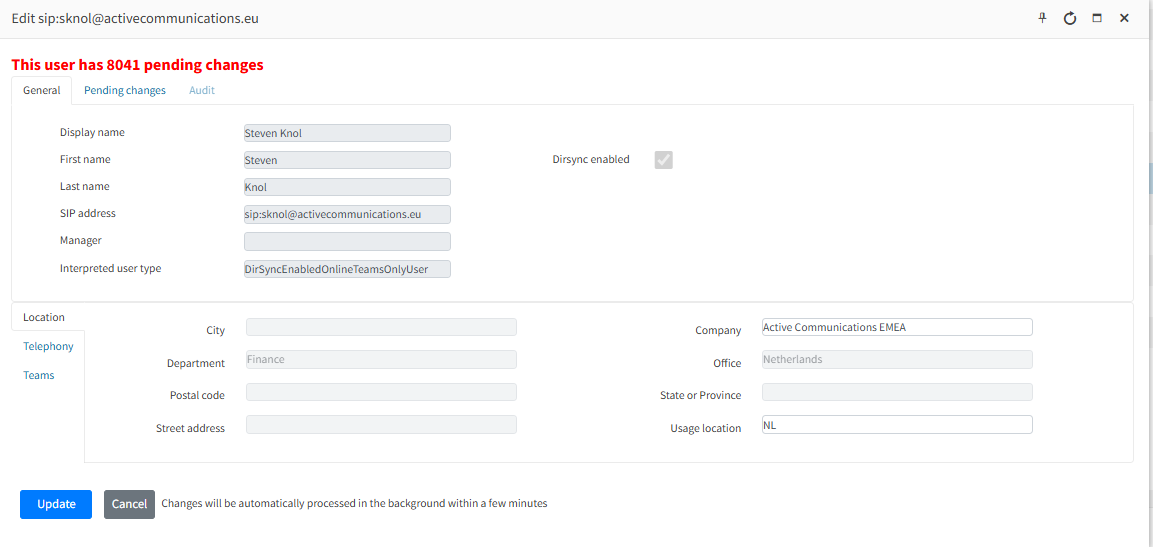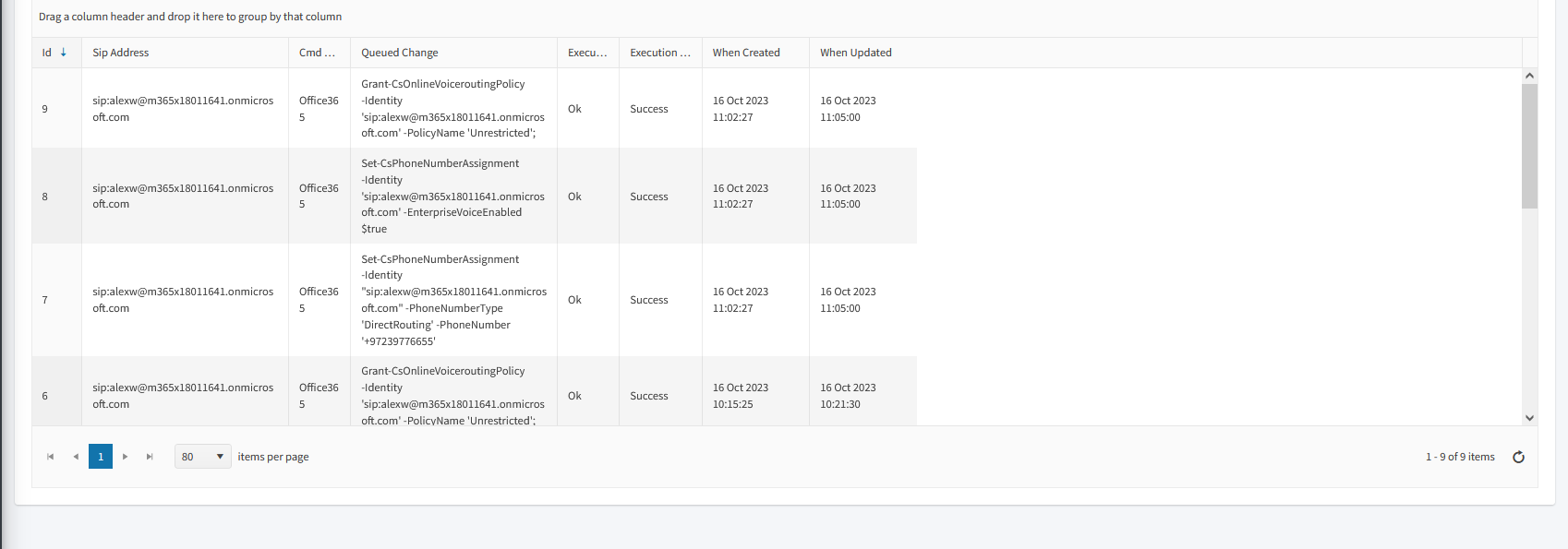Manually Applying M365 User Policies
M365 Teams Calling policies can be applied to users. A subset of these policies can be applied in the Users page. Applying the full list of policies must be done using templates and then assigning theses templates to Security Groups including the managed users (see LifeCycle Management Templates).
| ➢ | To edit user policies: |
| 1. | In the Customer portal Users page, select a user, right-click and then choose Edit to edit User policies. |


The following figure shows an example user policy.

| 2. | Refer to the following table. |
|
Parameter |
Description |
||||||||||||||||||||||||||||||
|---|---|---|---|---|---|---|---|---|---|---|---|---|---|---|---|---|---|---|---|---|---|---|---|---|---|---|---|---|---|---|---|
|
Display Name |
Display Name in Microsoft 365 and Customer portal. |
||||||||||||||||||||||||||||||
|
First Name |
First Name of M365 user. |
||||||||||||||||||||||||||||||
|
Last Name |
Surname of M365 user. |
||||||||||||||||||||||||||||||
|
SIP address |
SIP URL of M365 user. |
||||||||||||||||||||||||||||||
|
Manager |
Manager in charge of M365 user |
||||||||||||||||||||||||||||||
|
Interpreted User Type |
Teams Only |
||||||||||||||||||||||||||||||
|
DirSync Enabled |
Directory Sync Enabled |
||||||||||||||||||||||||||||||
| Location | |||||||||||||||||||||||||||||||
|
City |
City of user location. |
||||||||||||||||||||||||||||||
|
Department |
Active Directory department of user. |
||||||||||||||||||||||||||||||
|
Postal Code |
Postal Code |
||||||||||||||||||||||||||||||
|
Street Address |
Street address of the user work location. |
||||||||||||||||||||||||||||||
|
Company |
Name of the user's employment enterprise. |
||||||||||||||||||||||||||||||
|
Office |
Office address |
||||||||||||||||||||||||||||||
|
State or Province |
State or Province (relevant for countries with states or provinces). |
||||||||||||||||||||||||||||||
|
Usage location |
Country for which Enterprise calling is enabled. |
||||||||||||||||||||||||||||||
|
Telephony |
|||||||||||||||||||||||||||||||
|
Enterprisevoice Enabled |
Enables users to make and receive calls. |
||||||||||||||||||||||||||||||
|
Tms.SBA.Policy |
Assign Teams Branch Survivability policy to user. |
||||||||||||||||||||||||||||||
|
Select Numberrange |
Enables configuration of number ranges. |
||||||||||||||||||||||||||||||
|
Online Voicerouting Policy |
Applies Online Voice Routing policy. Default "Unrestricted" created by the Onboarding script. |
||||||||||||||||||||||||||||||
|
Tenant Dialplan |
Numbers added are automatically applied to the tenant dialplan. |
||||||||||||||||||||||||||||||
|
Line URI |
User assigned phone number. This configuration can also be performed using the Assign Phone Number right-click option (see Manually Assigning Phone Numbers to Users); for Hosted Essentials customers, numbers can only be assigned using this right-click option. |
||||||||||||||||||||||||||||||
|
Available nr (s) |
|
||||||||||||||||||||||||||||||
|
Teams |
|||||||||||||||||||||||||||||||
| App Permission |
|
||||||||||||||||||||||||||||||
| Call Park |
|
||||||||||||||||||||||||||||||
| Emergency Call Routing |
|
||||||||||||||||||||||||||||||
| Messaging Policy |
|
||||||||||||||||||||||||||||||
| SBA Policy |
|
||||||||||||||||||||||||||||||
|
Audio Conferencing Policy |
|
||||||||||||||||||||||||||||||
|
Emergency Calling |
|
||||||||||||||||||||||||||||||
|
Meeting Policy |
Global AllOff AllOn Default Kiosk RestrictedAnonymousAccess RestrictedAnonymousNoRecording |
||||||||||||||||||||||||||||||
|
Online Voicemail Policy |
TranscriptionDisabled TranscriptionProfanityMaskingEnabled |
||||||||||||||||||||||||||||||
|
Upgrade Policy |
|
||||||||||||||||||||||||||||||
| 3. | Perform the required modifications and then click Update. |
| 4. | Select the Pending changes tab. Updates are displayed. |

| 5. | In the Navigation pane, select Monitoring > Queued Changes. View the above changes in the Synchronization queue. |

| 6. | Return to the Users screen, notice that the User has been updated. |
